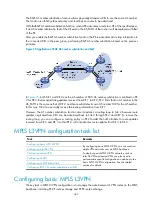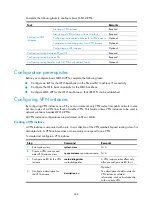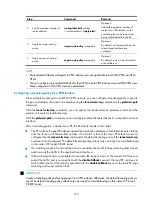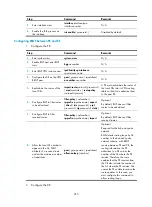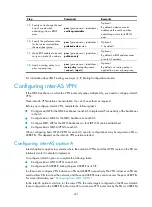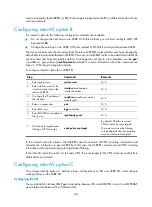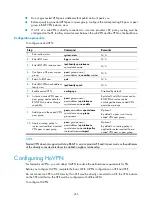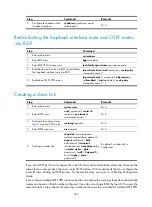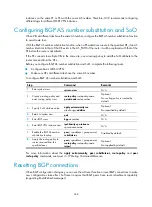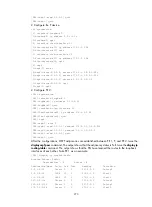
258
Configuring routing between PEs
Step Command
Remarks
1.
Enter system view.
system-view
N/A
2.
Enter BGP view.
bgp
as-number
N/A
3.
Configure the remote PE as
the peer.
peer
{
group-name
|
ip-address
}
as-number
as-number
N/A
4.
Specify the source interface
for route updates.
peer
{
group-name
|
ip-address
}
connect-interface
interface-type
interface-number
By default, BGP uses the source
interface of the optimal route
update packet.
5.
Enter BGP-VPNv4 subaddress
family view.
ipv4-family vpnv4
N/A
6.
Enable the exchange of
BGP-VPNv4 routing
information with the specified
peer.
peer
{
group-name
|
ip-address
}
enable
By default, BGP peers exchange
IPv4 routing information only.
Configuring routing features for BGP VPNv4 subaddress family
With BGP VPNv4 subaddress family, there are a variety of routing features that are the same as those for
BGP IPv4 unicast routing. You can select any of the features as required.
Configuring common routing features for all types of subaddress families
For VPN applications, BGP address families include BGP VPN-IPv4 address family, BGP-L2VPN address
family, and VPLS address family. Every command in the following table has the same function on BGP
routes for each type of the address families and only takes effect for the BGP routes in the address family
view where the command is executed.
To configure common routing features for all types of subaddress families:
Step Command
Remarks
1.
Enter system view.
system-view
N/A
2.
Enter BGP view.
bgp
as-number
N/A
3.
Configure the remote PE as
the peer.
peer
ip-address
as-number
as-number
N/A
4.
Specify the interface for TCP
connection.
peer
ip-address
connect-interface
interface-type interface-number
N/A
5.
Enter address family view.
ipv4-family vpnv4
Use one of the commands as
needed.
l2vpn-family
vpls-family
6.
Allow the local AS number to
appear in the AS_PATH
attribute of a received route
and set the maximum number
of repetitions.
peer
{
group-name
|
ip-address
}
allow-as-loop
[
number
]
Optional.




